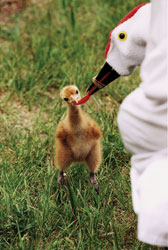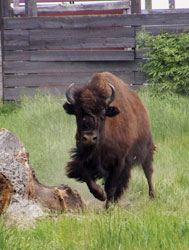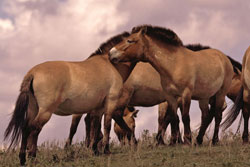Whoopers, Wild Horses and Marmots
 |
|
Igali, the Zoo’s Grevy zebra stallion, is isolated at the ranch for breeding. Zebra stallions are aggressive toward other species in the same enclosure, making it difficult for the Zoo to create multi-specie habitats. |
The horses at the Calgary Zoo ranch ain’t never been rode – and they ain’t never going to be.
They’re Przewalski horses, the world’s only truly wild breed, and the Zoo’s mandate is to keep them wild.
“We put wild animals back into the wild,” says Bob Peel, the curator of the Zoo ranch, officially known as the Devonian Wildlife Conservation Centre.
The Zoo ranch is a 320-acre captive breeding facility at DeWinton, south of Calgary, and is not open to the public. The ranch also serves as a Zoo quarantine and holding area for everything from elk to zebras.
The Zoo acquired the land in 1984 for breeding endangered species and hoofed stock. As international zoo demand for hoofed animals slowed in the 1990s, the ranch evolved into an important North American site for breeding endangered species to be reintroduced to the wild; Przewalski horses, whooping cranes and Vancouver Island marmots are the flagship species of the ranch’s conservation programs today.
Besides the breeding facilities, a clinic, staff housing and maintenance facilities, the ranch has 160 acres of hay and grain land and 30 acres of marshy lake, an important landing area for migratory waterfowl.
A full-time job at the Zoo ranch is difficult to get. The ranch employs two full-time journeymen zookeepers, bird specialist Dwight Knapik and mammal specialist Rick Wenman. The curator of the facility, Bob Peel, lives at the ranch but balances his time between curating the Canadian Wilds exhibit in the urban Zoo and the ranch.
 |
|
To prevent chicks from imprinting on humans, handlers are costumed to simulate an adult crane before feeding a whooping crane chick, an important factor for its survival as a wild bird |
Others, such as Nikki Yeoman and Val Edwards, just plain want to work with animals and are willing to accept minimum pay for the opportunity. Both graduated with a BSc and are building up their resumes to ultimately earn permanent positions. Nikki is an intern specializing in animal enrichment; her studies are funded by a federal grant. She has travelled as far away as Australia to gain zoo experience. It took her two tries to get this short-term internship at the ranch, and she had to demonstrate enough perseverance to beat out candidates with doctorate degrees.
Val, free-spirited and spontaneous, lives in a house on the ranch in return for work and some pay, but has to supplement her income by serving tables in a pizza house.
“I feed animals here in the day, and then I feed them at night in the pizza house!” she says with a laugh.
The ranch relies heavily on unpredictable, donated funding; Bob Peel says he lost one third of his funding for the cranes this year. Consequently, the ranch needs volunteers like Jeanette Green who also works in a vet clinic in Okotoks. Another volunteer, Wally Patterson, puts in long hours to keep the equipment running and the facilities repaired. Wally received a national award in 2005 recognizing his extraordinary commitment.
With more operating money, Bob says, the ranch facilities could be expanded to aid other endangered species, such as sage grouse.
Przewalski Horses
Przewalskis (pronounced serve OW ski) are believed to be the closest living relative of the domestic horse. Also known as Asian horses, Mongolian Wild horses or Takhi, they were native to Asia and became extinct in the wild.
 |
|
A Woods bison cow in the ranch frets in the quarantine paddock prior to introduction to the urban Zoo |
Their captive breeding is now monitored under a worldwide Species Survival Plan, an international program that controls the breeding of most zoo animals today. Siberian Tigers were the first SSP and the Calgary Zoo played a lead role in developing that program.
All the estimated 1,500 Przewalskis today are descended from 13 ancestors captured in Mongolia during the late 1800s and early 1900s. Przewalskis are virtually untameable, suspicious and very difficult to manage compared to modern domesticated breeds. They average 13 hands and are always a yellow dun with a black dorsal stripe and zebra striping on their legs.
They have no forelock and a bushy mane that stands on end. Researchers speculate that the first wild horses tamed thousands of years ago looked very much like the Przewalski horse.
“They are approachable during feeding times, but other than that … be careful,” one employee notes. The bitten-off tail of one mare is an example of how tough the horses are on each other – a trait the ranch does not discourage – as hard as it is sometimes to watch their merciless kicking of less dominant individuals.
To avoid breeding easier-to-handle horses, the ranch minimizes human contact with its herd of ten and, to replicate wild circumstances, the horses are expected to survive as they would in Mongolia … on about half the feed a comparable domestic horse would need.
 |
|
A Vancouver Island Marmot peeks out from a breeding box. The ranch is part of a nation-wide program to breed these endangered marmots for reintroduction to the wild. |
There were two schools of thoughts on how the horses could be reintroduced to the Mongolian steppes in the 1990s – the hard release versus the soft release. The soft release plan was to babysit the horses as they gradually acclimatized to the wild environment; researchers were concerned that the horses’ survival instincts may have been lost in captivity.
The Zoo ranch believed the horses could survive a hard release, one that simply opened the gate and let them go.
“We believed these were damn tough animals,” Greg Tarry, a former Zoo manager says. With the cooperation of Frances Gardner, owner of the Mount Sentinel Ranch south of Longview, Alberta, the Zoo ranch set up a trial release program.
“We let them go and watched,” Greg says. The results were very close to what was expected. The horses formed social groups of a dominant male and two mares, and a bachelor herd of males. The mares foaled and the herd was well on its way to reproductive success.
Today, at least 60 Przewalski horses live on their own at Hustain Huruu, a Mongolian steppe area.
The Whoopers
 |
|
Przewalski horses at the Zoo ranch are encouraged to form herds and survive on the same amount of feed as their wild counterparts, about half a domestic horse’s ration |
In the late 1800s, an estimated 500 to 1,400 whooping cranes inhabited North America. By the 1940s only 16 remained. Thanks to the work at the Zoo ranch and elsewhere, whooping cranes are making a comeback with 472 in the wild and in captivity.
The Zoo ranch was the first Canadian site designated for a captive flock, with two pairs arriving in 1992. The Nat Christie Whooping Crane Breeding facility opened in 1993 at the ranch. The first whooping crane chicks hatched at the ranch in 1996.
The Zoo has seven adult pairs of whooping cranes, two singleton breeding males, three juveniles hatched in 2005 and, so far, five chicks have hatched this year. There are also two cranes on display in the Zoo’s Canadian Wilds. To date, the Zoo ranch has released 16 chicks into the wild. In addition to the chicks hatched this spring, the Zoo shipped 10 fertile eggs to Patuxent, Maryland. Five of these eggs hatched and the chicks are destined to join the flock being trained in Operation Migration – an international effort that trains birds to migrate with ultra-light aircraft.
In addition to the wild flock that migrates from Wood Buffalo Park in Alberta to Aransas Texas, the whooping crane recovery team has created two other flocks. One has been trained to migrate from Wisconsin to Florida. The other flock is non-migratory.
Vancouver Island Marmots
Canada’s Most Endangered Animal
Vancouver Island’s wild marmot population drastically declined in the late 1980s and, in 1997, the first of these marmots was taken into captivity to establish a conservation breeding program. In 2000, the Zoo ranch was the first facility in the program to see successful reproduction. The ranch now has 14 marmots.
The marmots have a chocolate-brown fur coat and a whitish muzzle. They are the size of very large house cat, and hibernate seven months of the years. During hibernation, their hearts beat three or four times per minute. During their active season, their heart rates range from 110 to over 200 beats per minute.
Reintroduction is being carried out on Vancouver Island; from four marmots released in 2003, it is progressing toward a hoped-for 30 in 2007. The future of Canada’s rarest animal is looking brighter.
For information on how you can contribute to conserving endangered species at the Zoo ranch, contact Development at The Calgary Zoo, calgaryzoo.ab.ca.
Tyler Trafford’s latest non-fiction work, The Evolution of the Calgary Zoo, was released in June. Tyler’s latest fiction work, Alexander’s Way, was released in April as the second book in his Sun On The Mountains series of novels set in western Canada during the fur trading, ranching and oil eras. He has written articles for Canadian Cowboy Country since 2003. Photographer Cathy Ladiges is a 16-year zookeeper and was the 1981 Calgary Stampede Queen.
